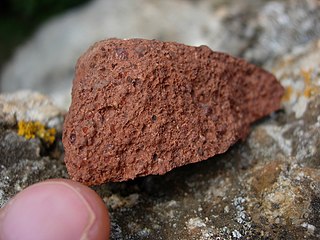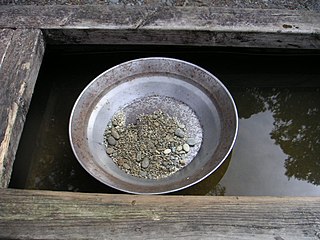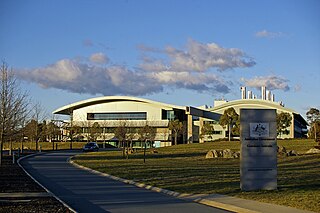Related Research Articles

Bauxite is a sedimentary rock with a relatively high aluminium content. It is the world's main source of aluminium and gallium. Bauxite consists mostly of the aluminium minerals gibbsite, boehmite and diaspore, mixed with the two iron oxides goethite and haematite, the aluminium clay mineral kaolinite and small amounts of anatase and ilmenite . Bauxite appears dull in luster and is reddish-brown, white, or tan.

Environmental geology, like hydrogeology, is an applied science concerned with the practical application of the principles of geology in the solving of environmental problems created by man. It is a multidisciplinary field that is closely related to engineering geology and, to a lesser extent, to environmental geography. Each of these fields involves the study of the interaction of humans with the geologic environment, including the biosphere, the lithosphere, the hydrosphere, and to some extent the atmosphere. In other words, environmental geology is the application of geological information to solve conflicts, minimizing possible adverse environmental degradation, or maximizing possible advantageous conditions resulting from the use of natural and modified environment. With an increasing world population and industrialization, the natural environment and resources are under high strain which puts them at the forefront of world issues. Environmental geology is on the rise with these issues as solutions are found by utilizing it.

Mining in the engineering discipline is the extraction of minerals from the ground. Mining engineering is associated with many other disciplines, such as mineral processing, exploration, excavation, geology, metallurgy, geotechnical engineering and surveying. A mining engineer may manage any phase of mining operations, from exploration and discovery of the mineral resources, through feasibility study, mine design, development of plans, production and operations to mine closure.

Prospecting is the first stage of the geological analysis of a territory. It is the search for minerals, fossils, precious metals, or mineral specimens. It is also known as fossicking.

Gold prospecting is the act of searching for new gold deposits. Methods used vary with the type of deposit sought and the resources of the prospector. Although traditionally a commercial activity, in some developed countries placer gold prospecting has also become a popular outdoor recreation. Gold prospecting has been popular since antiquity. From the earliest textual and archaeological references, gold prospecting was a common thread for gaining wealth.

The California Geological Survey, previously known as the California Division of Mines and Geology, is the California state geologic agency.

Geoscience Australia is a statutory agency of the Government of Australia that carries out geoscientific research. The agency is the government's technical adviser on aspects of geoscience, and serves as the repository of geographic and geological data collated by the Commonwealth.

Camborne School of Mines, commonly abbreviated to CSM, was founded in 1888. Its research and teaching is related to the understanding and management of the Earth's natural processes, resources and the environment. It has undergraduate, postgraduate and research degree programmes within the Earth resources, civil engineering and environmental sectors. CSM is located at the Penryn Campus, near Falmouth, Cornwall, UK. The school merged with the University of Exeter in 1993.

Xie Xuejin was a Chinese geochemist who won the AAG Gold Medal in 2007. Xie was considered as the Father of Geochemical Mapping in China.
Geologic mapping of Georgia is the creation of geologic maps—special-purpose maps made to show geological features—of the State of Georgia in the United States. Rock units or geologic strata are shown by colors or symbols to indicate where they are exposed at the surface. Structural features such as faults and shear zones are also shown. Since the first national geological map, in 1809, there have been numerous maps which included the geology of Georgia. The first Georgia-specific geologic map was created in 1825. The most recent state-produced geologic map of Georgia, by the Georgia Department of Natural Resources is 1:500,000 scale, and was created in 1976 by the department's Georgia Geological Survey. It was generated from a base map produced by the United States Geological Survey. The state geologist and Director of the Geological Survey of Georgia was Sam M. Pickering, Jr. Since 1976, several geological maps of Georgia, featuring the state's five distinct geologic regions, have been produced by the federal government.
The Mines and Steel Development Ministry is a Nigerian ministry established in 1985 to encourage development of the country's solid mineral resources. The Ministry formulates policy, provides information on mining potential and production, regulates operations and generates revenue for the government. Operational departments include Mining cadastre , Geological survey of Nigeria, Mines inspectorate, Artisanal and small-scale mining and Mining environment.
Boogardie is an abandoned town in the Mid West region of Western Australia.
The Geological Survey of Western Australia is an authority within the Department of Mines and Petroleum of the Government of Western Australia that is responsible for surveying and exploration of Western Australia's geological resources. The department provides information to industry, technical support and professional guidance to government on geology, mining and petroleum resources.

The Mines and Geosciences Bureau (MGB) is a government agency of the Philippines under the Department of Environment and Natural Resources (DENR). The MGB is responsible for the conservation, management, development, and use of the country's mineral resources, including those in reservations and public lands.

The Ministry of Mineral Resources (MMR) Sierra Leone is located on the 5th Floor Youyi Building, Brookfields, Freetown, Sierra Leone. Further to this the MMR Geological Surveys Department can be found at the New England estate, also in Freetown. The Ministry supports a network of regional offices in Makeni, Bo, Kenema and Kono, each headed by a Government Mines Engineer.

The Nevada Bureau of Mines and Geology (NBMG) is a research and public service unit of the University of Nevada and the State Geological Survey. NBMG is also part of the Mackay School of Earth Sciences and Engineering at the University of Nevada in Reno. Scientists with the NBMG conduct research and publish their findings around topics which include, mineral and energy resources, engineering geology, environmental geology, earthquakes, groundwater, and geologic mapping in Nevada. In addition, the NBMG provides special services in the field of analytical geochemistry and assay standards, mineral and rock identification. The NBMG provides earth-science education and in-service teacher training and continuing education for professional geoscientists, geologic and geotechnical information.

Jane Anne Plant CBE, FREng, FRSE, FRSA (1945–2016) was a leading geochemist, scientist, and author. Plant was a pioneer in the field of geochemical surveys and environmental surveys. She was Chief Scientist at the British Geological Survey and was a Professor of Geochemistry at Imperial College London. Plant was also highly involved in the Institution of Mining & Metallurgy where she was involved in many aspects including a role on the Council, and was the first female President of the Institution of Mining & Metallurgy, a post she held from 2001 to 2002. This gave her an extensive network of key connections with government, industry and academia.
The McBride Project is a 880 hectare plot of land located near Limerick, Ontario, Canada. It contains an estimated 5.1 million tons of nickel-cobalt-copper mineralization near the earth's surface.

The Geological Survey of Tanzania or GST is a scientific department under the Tanzanian government. The scientists of the GST investigate the landscape of Tanzania, as well as its natural resources and potential hazards. The work of the organization is interdisciplinary and includes biology, geography, geology, and hydrology. The GST is a fact-finding scientific group without that works with the Ministry of Minerals. In 1925 the agency was established under the British colonial government. Mussa Daniel Budeba, a geologist, is the organization's current chief executive officer.
References
- ↑ "Zimbabwe Geological Survey". Geographic Information System.
{{cite web}}: Missing or empty|url=(help) - ↑ Harare, Ngoni. "Zimbabwe carrying out Geological Mineral Survey". The Zimbabwean. Retrieved 15 March 2013.
- ↑ "Gold". The Chamber of Mines of Zimbabwe. Retrieved 15 March 2013.
- ↑ "Zimbabwe Regional Geochemical Survey" . Retrieved 15 March 2013.
- ↑ "MINING IN ZIMBABWE". The Association of Mine Surveyors in Zimbabwe. Retrieved 15 March 2013.